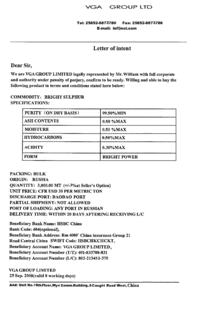Letter of intent

A letter of intent (LOI or LoI, and sometimes capitalized as Letter of Intent in legal writing, but only when referring to a specific document under discussion) is a document outlining one or more agreements between two or more parties before the agreements are finalized. The concept is similar to a heads of agreement, term sheet or memorandum of understanding. Such outlined agreements may be mergers and acquisitions transaction agreements,[1] joint venture agreements, real property lease agreements and several other categories of agreements that may govern material transactions.
- LOIs resemble short, written contracts, but are usually in tabular form and not binding on the parties in their entirety. Many LOIs, however, contain provisions that are binding, such as those governing non-disclosure, governing law, exclusivity or covenants to negotiate in good faith.[1] An LOI may sometimes be interpreted by a court of law as binding the parties to it if it too-closely resembles a formal contract and does not contain clear disclaimers.[2]
A letter of intent may be presented by one party to another party and subsequently negotiated before execution (or signature.) If carefully negotiated, an LOI may serve to protect both parties to a transaction. For example, a seller of a business may incorporate what is known as a non-solicitation provision, which would restrict the buyer's ability to hire an employee of the seller's business should the two parties not be able to close the transaction. On the other hand, an LOI may protect the buyer of a business by expressly conditioning its obligation to complete the transaction if is unable to secure financing for the transaction.[3]
Purposes of an LOI
Common purposes of an LOI are:
- To allow parties to sketch out fundamental terms quickly before expending substantial resources on negotiating definitive agreements, finalizing due diligence, pursuing third-party approvals and other matters[1]
- To declare officially that the parties are currently negotiating, as in a merger or joint venture proposal
- To provide safeguards in case a deal collapses during negotiation
- To verify certain issues regarding payments made for someone else (e.g., credit card payments)
Potential downsides to using an LOI may include:
- The parties may engage in protracted negotiations on only a subset of a deal’s terms
- Management time and focus may be diverted
- Alternative opportunities may be missed and markets may move against the parties during negotiations
- Parties may reduce their lack of a workable deal framework into an LOI, with a hope of making progress later
- Public disclosure obligations may be inadvertently triggered
- The risk of leaks, exacerbated by the desire of some to tout the LOI to the world, or shop it to other parties[1]
Specific examples
In academia, a letter of intent is part of the application process, in which it is also known as a statement of purpose or application essay. In education in the United States, letters of intent are also frequently reached between high school senior athletes and colleges/universities, for the reservation of athletic scholarships for the athletes upon graduation from high school. School administrators in secondary education often require a letter of intent before approving the formation of a student club.
In real estate, in cases where the real property in question is not listed on a multiple listing service, there may not be an easy way to notify the owner of the property and other interested parties of intent to purchase. Often it is necessary to officially begin the process of a purchase, and allow all peripheral interested parties to begin any other processes, with a letter of intent. For example, a multimillion-dollar loan for a commercial property may require a letter of intent before a financial institution will allow personnel to spend time working on said loan necessary for the completion of the sale. The same may be followed at the time of purchase by any company.
In the solicitation of government grants, a letter of intent is highly encouraged but it is not required or binding, and does not enter into the review of a subsequent application. The information that it contains allows agency staff to estimate the potential workload and plan the review.[4]
See also
References
- 1 2 3 4 Lopez, Erik (July 20, 2015). "What you need to know about M&A letters of Intent". The M&A Lawyer Blog. Jasso Lopez PLLC. Retrieved August 28, 2015.
- ↑ Burwell, Robert (July 8, 2013). "When a Non-binding Term Sheet Becomes Binding". Mintz Levin. Mintz Levin Cohn Ferris Glovsky and Popeo PC. Retrieved August 28, 2015.
- ↑ http://exitpromise.com/letter-of-intent-to-buy-or-sell-a-business/
- ↑ Typical example: 2008 Grant Solicitation for Consumer-Controlled Health Record Bank Pilots (PDF), Washington State Health Care Authority, archived from the original (PDF) on July 23, 2008, retrieved 2008-05-21